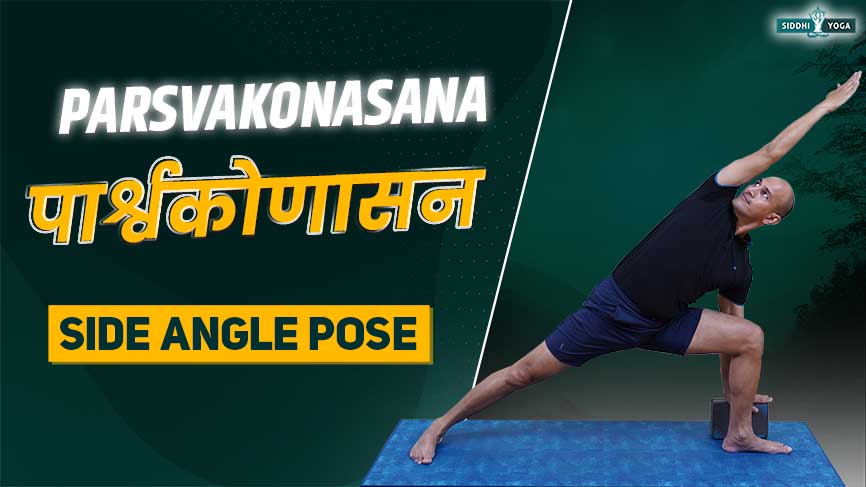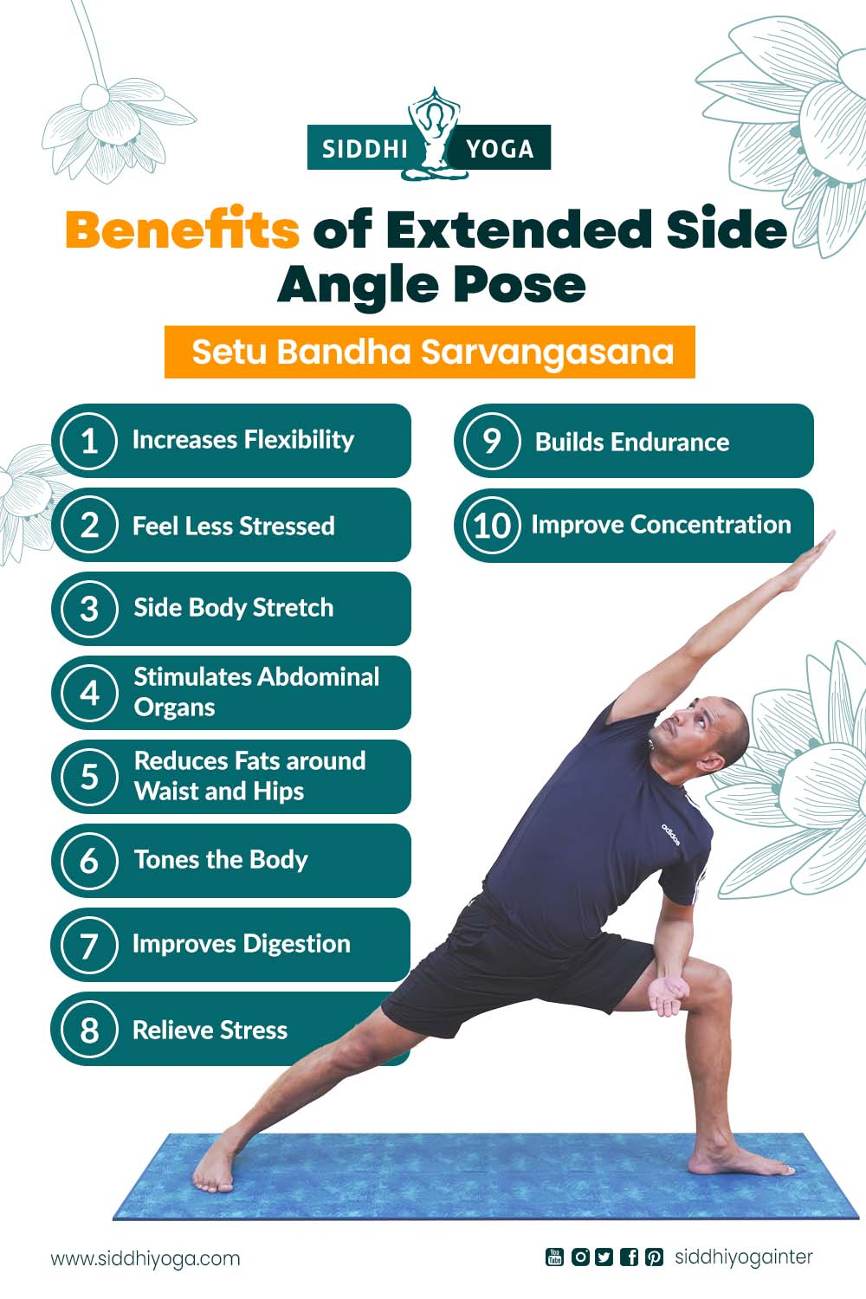
Kona: Angle
体式:姿势
Parsvakonasana 概览
Side Angle Pose or Parsvakonasana is a yoga where you stretch your body with one arm and the other on the thigh or the floor. The pose is excellent for enhancing your 精神成长. It is one of the best poses to maintain strength and flexibility.
好处
- 它有助于 strengthen thighs, groin, hamstrings, calves, and hips, thus enhancing flexibility.
- 这个姿势 enhances spinal flexibility due to its twisting movement.
- It improves core strength and stability by involving the abdominal muscles.
- It improves the lung capacity by opening the chest completely.
谁可以做?
Healthy people who want to improve flexibility in hip flexors, shoulder joints, and thighs can practice side angle poses.
谁不应该这样做?
员工 with lower back pain, shoulder injury, knee injury, hip injury, pregnant women in their later stages, high blood pressure, recent surgery, and balance issues should avoid or modify this side angle pose. It is one of the asanas of the 阿斯汤加 series and is a popular pose in yoga sequences.
介绍
Parsvakonasana, or Side Angle Pose, is a yoga pose with a side stretch with one of the arms and the other arm, hence a side angle pose. The pose offers a variety of benefits both physical as well as mental. The pose is believed to relieve mental and emotional stress. It is a part of the primary series of 阿斯汤加瑜伽 and is a major asana in other yoga sequences.
脉轮:
Side Angle Pose stimulates mainly 脐轮. This chakra is the powerhouse of the body. It helps a practitioner to activate the body’s energy with stability and balance. The pose demands both strength and balance. When practiced correctly, it helps to strengthen the overall body. Due to its side stretch, the pose detoxifies the body and is a mood elevator.
经营理念:
It helps to find steadiness and ease in your pose. This pose requires strength and comfort, which helps expand and balance the growth in a practitioner’s life. By practicing this pose, one can work on energy and spiritual growth. The pose needs a lot of patience to hold for a longer duration in a side-angle pose, so in a way, it teaches a practitioner to be patient and stable.

怎么做 Parsvakonasana?
遵循分步程序
- Start with your right foot at a right angle with the floor and your left leg straight.
- Inhale, keep the pelvis neutral and the left foot slightly inside.
- Exhale, lean into the right hip joint and bend your right knee with your right heel slightly inward.
- Keep your thigh parallel to the floor.
- Keep your right knee in line with your ankle.
- Stretch the left leg behind. There should not be any strain on your right bent knee.
- Lift your right arm outside your right foot with your palm facing the floor and your foot turned at a right angle, or keep your right arm on your right thigh. Roll your shoulder blades away from your ears.
- Keep your right foot firm on your yoga mat. Feel the stretch on your right thigh.
- Keep the alignment of the right thigh in one plane with your body.
- Extend your left arm next to the left ear, lengthening the entire left side of the body, thus maintaining the side bend. Keep your arm straight. Keep your spine straight. Open your chest.
- Work on the muscles of the inner thighs of both legs.
- Gaze straight ahead at your left fingertips, underneath the left armpit. Shift slightly your upper torso on the upper side to open the chest. This is the side angle pose Parsvakonasana.
- Maintain deep breaths. Hold the pose for a few breaths. Engage your inner thighs. Keep the bent knee thigh involved.
- Release the pose slowly by pressing your back heel into the floor and repeat the same steps with your left foot forward.
- Use blocks, if needed.
有什么好处 Parsvakonasana?
- It helps to tone and strengthen knees, shoulders, ankles, thighs, and legs.
- It aids in good digestion by stimulating the digestive organs.
- It helps to release emotions since it is a side stretch and opens the heart completely.
- It is a good pose for respiratory issues since it is a chest opener.
- It greatly enhances the flexibility of the overall body.
- It alleviates mild lower back issues and sciatica pain.
- It is a good pose for a sedentary lifestyle and people with tight hips.
- It eases menstrual discomfort and pain.
可能受益的健康状况 Parsvakonasana
- It promotes good digestion by massaging the abdominal organs.
- The twisting movement helps to detoxify the body, releasing toxins.
- The pose is good for people who want to increase flexibility, especially in the hips, and groins.
- The pose alleviates menstrual discomfort and pain.
- It releases stress and anxiety by detoxifying the body.
- It opens up the chest so is a good pose for people with respiratory issues.
- It relieves symptoms of insomnia.
- The pose is good for athletes.
安全注意事项
- Parsvakonasana or Side Angle Pose should be avoided by people who have high blood pressure, or they should modify the pose.
- People with cardiovascular diseases should avoid it.
- People with recent or chronic hip, knee, and shoulder injuries should avoid the pose.
- People suffering from migraines and headaches should modify or avoid the pose.
- Pregnant women should practice this pose with caution. Consult a yoga teacher.
- People with balance issues should avoid the pose.
- People with digestive disorders should avoid the pose or modify it.
初学者提示
- Start with a gentle warm-up to stretch your hip, thigh, and shoulder joint.
- Use a yoga block to reach the floor, if needed.
- Do not jump into the pose quickly. Maintain deep breaths throughout the pose.
- Focus on the alignment of the spine. Keep your bent leg at a right angle with the floor.
- Keep your bent knee and ankle in one line. Do not strain your knee while it’s bent.
- Keep your chest open. Engage your core.
Parsvakonasana 和呼吸
- Inhale, stand straight, exhale, and keep your right foot at the right angle and the left foot straight.
- Inhale again and Exhale. Bend your right thigh and shift your body forward. Place your right arm over your right thigh or it can reach the floor, if possible. Simultaneously, stretch your left hand up over your head.
- Inhale and exhale, relax your muscles, lift your chest and maintain deep breathing.
- Maintain the alignment of the spine and keep your shoulder relaxed. Hold the pose with a few deep breaths.
- To release the pose, inhale and exhale. If your right arm is touching the floor, place it on the right thigh, and if it is already on your right thigh, inhale, release the stretched left arm, and relax.
- Inhale and Exhale, come to the star pose. Exhale, keep your left foot at the right angle and the right foot stretched back. Repeat the same steps by bending to your left side this time.
- Maintain deep breathing throughout the pose and finally exhale to release the pose. Come back to the starting position, standing straight.
Parsvakonasana 和变化
- You can keep your feet hip-width apart. Place your right foot at the right angle, and the left rotates slightly inwards.
- Keep your knee in one line with your ankle. Reach your elbow to your thigh, place your right hand on the floor, and extend the left arm over your head. Keep your back leg with your upper arm stretched, making it a side angle pose Parsvakonasana,
- keep the chest lifted and gaze up. Maintain deep breaths. Repeat the same steps, switching legs.
- You can clasp your fingers inside your thigh for a half-bind pose.
- You can support your front thigh on a chair if your knees are painful. Keep the leg’s alignment parallel to the chair’s front edge. This will take up the entire body weight on the chair. With practice, you can learn to develop the strength in the pose.
- You can use a yoga block to reach on the floor to support your hand. Engage your core and follow the same steps.
- You can use a wall against your back foot to maintain its alignment and support for the wide angle.
加深姿势
- You can create a deep stretch in the side angle pose Parsvakonasana by placing one of your arms to reach the floor and extending the other over your head. Keep your feet wide enough so your torso, stretched leg, and head are in one line.
- Maintain deep breathing throughout the pose. Keep your hips square. Coordinate your movements with the breaths to deepen the pose. Allow your pelvis to rotate. Look up at the stretched arm. Keep your chest open and lifted.
- Inhale stretch and exhale; relax your muscles.
物理对齐原则 Parsvakonasana
- You can start in 忠贞 (Mountain Pose), inhale, step out your right foot outside at the right angle, and maintain your left foot inside. Focus on this alignment.
- Keep the feet wide enough to stretch the back foot comfortably. Your back foot should be in a straight line with your stretched hand.
- Your knees should not come out of your ankles. Keep the back leg firm on the yoga mat. Engage your back leg and core to maintain the proper straight alignment of a stretched angle in the pose.
- Pull your navel in, keep breathing, and do not hold your breath at any time of the movement of the pose.
- Keep your spine straight. When you look up during the pose, look at the stretched hand with proper breathing.
- Keep your chest lifted, do not round your shoulder, and do not lean forward.
- Feel the stretch on your thighs. Maintain the alignment by keeping your thigh of the bent leg pulled back and in a plane with your body. Could you not allow it to collapse in front?
常见错误
- Do not rush to be in the final pose too early. Practice a few warm-ups to open your body.
- Maintain deep and conscious breathing. Keep the stretched hand involved with the spine straight and chest open. Keep your feet in one line. The distance between them should be such that you make a comfortable right angle with one of your legs.
- While keeping your elbow on your thigh there should not be any strain on your neck. Engage your core and keep your shoulders relaxed. Relax in the final pose. Do not overlook any strain or pain in the body. Modify the pose accordingly.
准备姿势
- Shoulder and Neck Rotations, External and Internal Hip Rotations
- 马加里亚式 (Cat-Cow Stretch)
- 乌特卡塔·科纳萨纳 (女神姿势)
- 维拉巴德拉那那 (Warrior I)
- 毗连体式 II (Warrior II Pose)
- 乌蒂塔·特里科纳萨纳(Utthita Trikonasana) (三角姿势)
底线
Parsvakonasana is a pose that should be introduced in your everyday yoga routine. It is an excellent side stretch and mood elevator. Being practiced in many yoga sequences, it has many benefits besides just staining flexibility and strength. With practice, it helps to acquire patience and spiritual growth of a practitioner.
您对瑜伽充满热情并梦想教别人吗? 我们全面的瑜伽老师培训课程可以满足您的需求! 探索 200小时瑜伽老师培训课程,更深入地研究你的实践 300小时瑜伽老师培训课程, 或掌握教学艺术 500小时瑜伽老师培训课程 – 均获得瑜伽联盟认证。 您成为认证瑜伽教练的旅程从这里开始。 来参加我们的 今天就让你的瑜伽之旅绽放吧!